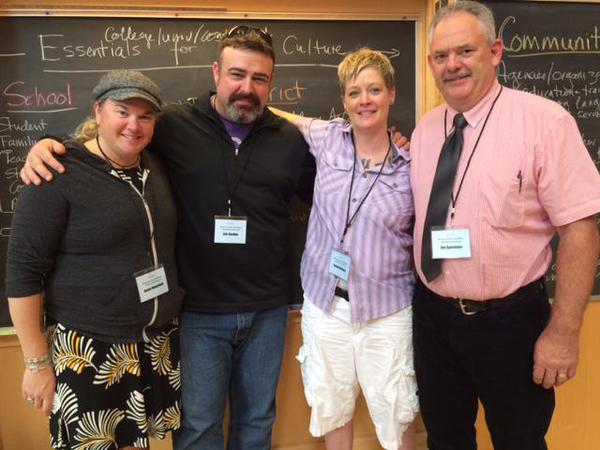About 120 educators from in and around Sacramento County met on Saturday, Oct. 17, for day two of Beyond Trauma: Building a Resilient Sacramento, which was held at the gorgeous campus of Meristem in Fair Oaks. The workshop was co-sponsored by Kaiser Permanente, The California Endowment, Meristem and ACEs Connection Network. More than 100 people from across sectors attended the first day which was capped by a screening of Paper Tigers at the Crest Theater. The documentary tells the story of Lincoln High School in Walla Walla, WA, the first trauma-informed high school in the U.S., through a year in the life of six students.
The second day of the workshop focused on education. It was led by the people in the above photo: (l to r) Lincoln High School teachers Genie Huntsman and Erik Gordon; former Lincoln HS counselor (now with Children's Resilience Initiative) Brooke Bouchey; and former Lincoln HS Principal Jim Sporleder. (Videos and other information from the workshop will be posted on the Sacramento County ACEs Connection group later.)
At the end of the day, I led an exercise in which we, as a group, listed some essentials for an ACEs-, trauma-informed, resilience-building school system. The categories are essential, too: classroom, school, school district and community. We don't pretend that this is a formula, but we think that all these pieces are....well...essential. How school systems and communities integrate these essentials is up to them, and they may find other elements not on this list that are important.
We also know, since ACEs-, trauma-informed, resilience-building school systems are in their infancy, that this list is a starting point. So, if you have anything else to add, please do so in the comments.
We will add resources listed below into resources for this group, and expand those resources. If you have other resources, please add them in the comments, and we'll integrate. Thank you!
Classroom
Students -- Are taught social-emotional learning, from kindergarten; can ask to use peace corners, go to wellness rooms or buddy classes to de-stress.
Teachers -- Are steeped in ACEs-, trauma-informed, resilience-building practices, including understanding about their own ACEs and the importance of self-care.
Rooms -- Have peace corners with age-appropriate tools to destress, including beanbag chairs, crayons and paper, books, etc.
Note: Class sizes are small -- 25 students or less.
Resources and tools for an ACEs-, trauma-informed, resilience-building classroom:
ConsciousDiscipline.org
Safe & Civil
PBIS
SEL programs
Restorative justice/practice
School
Policies -- All policies for students, teachers, staff and administration examined through a trauma-informed lens, and changed so that nobody is further traumatized.
System in place to handle different levels of needs in students, teachers, staff and administration (this means teachers handle most students' challenges, then counselor, social workers, with psychologists working with most troubled students and families. Regular review of progress of students who are having the most troubles.
Training -- Everyone is steeped in ACEs-, trauma-informed, resilience-building practices, including:
Students
Family/caregivers
Teachers
Staff
Counselors/social workers/psychologists/nurses
Administrators (who understand the relationship between trauma & academics)
Hiring -- All who are hired either know about ACEs-, trauma-informed, resilience-building practices or are willing to be trained in the information.
Building --
Wellness room in which students can de-escalate
Health center
School District
Leadership -- Steeped in ACEs-, trauma-informed, resilience-building practices.
Pilot -- Implement ACEs-, trauma-informed, resilience-building practices in one elementary school, one middle school and one high school before implementing district-wide policy. In other words, this grows from the ground up, not the top down.
Policy -- Examine all policies so that school system no longer traumatizes already traumatized students, teachers, staff and administrators, and implement resilience-building policies.
Hiring -- Hire more teachers
Funding -- Advocate for more state funding to support transition
"Articulated" system -- Coordination in practice, policy and student hand-off between pre-K and elementary, elementary and middle, middle and high school, high school and community college.
Resources:
Project Prevent
Community
Awareness/Education -- All community agencies/organizations/peer teams across sectors (healthcare, public health, education, social services, nonprofits, law enforcement, criminal justice, juvenile justice, business, faith-based) educated in ACEs-, trauma-informed, resilience-building practices to develop a common language and to coordinate services. All agencies/organizations make commitment to also integrate ACEs-, trauma-informed, resilience-building practices and develop mutual assistance programs and network. Trauma-informed, resilience-building practices include cultural awareness and practice, education about racism and system-induced trauma.
Parenting classes -- For all parents, to help them recognize challenges of parenting with ACEs, and to provide transition to healthy parenting that does not blame or shame them.
Teacher/administrator education -- Colleges and universities integrate ACEs-, trauma-informed, resilience-building practices into all coursework, as well as into their own policies, programs and buildings.
Support groups -- Peer organizations across sectors; organizations such as Alateen; parent support groups are created if they don't exist and integrate ACEs-, trauma-informed, resilience-building practices.
Resources:
[If you have resources, or any other info to add to this list -- and I'm sure there are many items and resources to add -- please leave them in the comments!]



Comments (18)